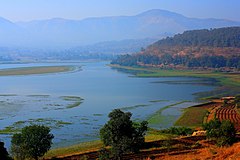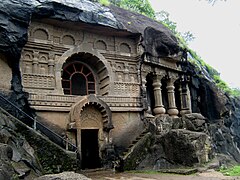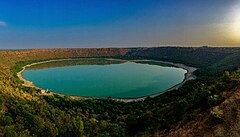Tourism in Maharashtra

Metropolitan Areas
Mumbai
The city is the eastern equivalent of
Nashik
The city is famous for its Nashik grape and Vineyards. It is known as "The Wine Capital of India" owing to 26 wineries being located here out of a total of 46 throughout India. Several wine festivals and wine tasting tours are held in this region.[citation needed] Nashik is also surrounded by various forts and hills and has an abundance of hiking trails.
A 108 feet tall statue of the first Jain Tirthankar Rishabhanatha was consecrated at Mangi Tungi in 2016, which is the tallest Jain statue in the world. The place has now become a major pilgrimage and tourist destination in the state.[citation needed]
The city also has a lot of religious and mythological significance. Lord Rama lived in Panchavati during his exile as mentioned in the epic Ramayana. It is famous for its numerous temples like Kalaram Temple, Trimbakeshwar Temple - one of the 12 Jyotirlingas. The river Godavari River, also known as the Ganga of the South, originates from the Brahmagiri Hills in Trimbakeshwar. The Nasik-Trimbakeshwar Simhastha is one of the four Kumbh Melas held every 12 years in Nashik.[5]
Pune
Pune district has been at the center of History of Maharashtra for more than 400 years, beginning with the Deccan sultanates and followed by the Maratha Empire. The district has a number of mountain forts and buildings from these eras, in addition to shrines revered by Marathi Hindus (including five of the eight Ashtavinayaka Ganesha temples). Samadhis of the two most revered Marathi Bhakti saints (Dnyaneshwar and Tukaram) are in Alandi[6] and Dehu, respectively. The main temple of Khandoba, the family deity for most Marathi Hindus, is in Jejuri.[7]
The British designated Pune as the monsoon capital of the
Bhigwan, a catchment area of the Ujjani Dam, is about from Pune on NH 9, the Pune-Solapur highway. An area of about 18,000 hectares (69 sq mi) has become a sanctuary for migratory birds.
In January 2021, the prison department of Maharashtra announced jail Tourism at the
Aurangabad
This citys also known as Aurangabad, in the central part of Maharashtra and attracts tourists for its natural beauty. The
Nagpur
With a tradition of producing the best
Beside these Nagpur has much historical significance. Deekshabhoomi - the place where Dr. Babasaheb Ambedkar and lakhs of the so-called lower caste who deemed as untouchables by Hindu caste system, embraced Buddhism. Another important place to visit is Tekadi Ganesh mandir on Sitabuildi fort complex. The city has other places of tourist importance such as Maharajbagh zoo, and Futala lake Chowpati, Nagpur is well connected with all major cities of India by roadways and railways, and also have an international airport. Dr. Babasaheb Ambedkar International Airport (IATA: NAG, ICAO: VANP) is an international airport serving the city of Nagpur, Maharashtra, India. In 2005, it was named after B. R. Ambedkar, the chief architect of the Indian Constitution.
Satara
Nature tourism
Maharashtra has tremendous potential for Nature Tourism. Many private and public organizations have begun unique and innovative forms of nature tourism.
Hill stations

During the
- Amboli
- Chikhaldara - in Satpura mountains
- Igatpuri - On Main Mumbai - Bhusawal railway line
- Jawhar
- Karjat - On Main Mumbai - Pune railway line
- Khandala- On Main Mumbai - Pune railway line
- Lonavala - On Main Mumbai - Pune railway line
- Bombay presidency during the British Raj
- Matheran - linked to the main Mumbai - Pune railway line with a narrow gauge mountain train.
- Panchgani - Close neighbour of Mahabaleshwar with many colonial-era boarding schools.
- Panhala
- Toranmal
Lavasa is a very recently developed township and is under private control.
Religious Tourism
Maharashtra boasts of a large number of popular and revered religious venues that are heavily frequented by locals as well as out-of-state visitors.
Hindu places of pilgrimage
A number of temples such as Bhimashankar, Trimbakeshwar, Bhavani of Tuljapur, Shani Shingnapur, Jyotiba Temple, Ashtavinayaka Ganapati temples, Lord Pandurang temple at Pandharpur attract a huge number of Hindu devotees every year. Khandoba temple of God Khandoba at Jejuri in the Pune district attract pilgrims from all over the Maharashtra where worshipers shower each other with Bhandar (turmaric powder).< Saibaba temple at Shirdi is visited by an average of 25,000 pilgrims a day and during religious festivals, this number can reach up to 300,000.
- Warkari sect such as Sant Tukaram memorial at Dehu, and Samadhi of Sant Dnyaneshwar at Alandi remain popular throughout the year, and attract huge number of people from all over the state during religious observations.[15]

Marathi Hindu families have a family deity called Kuldevta that they visit after many auspicious events.Important ancient Kuldevta temples that attract pilgrims in the state include:
- Shakti Peetha, is located in the Nanded district.
- Goddess Bhavani
- Kolhapur -Temple of Goddess Mahalaxmi or Ambabai
- Shaktipeethasin the state.
- Jejuri - Temple of Khandoba[16]
Many temples or shrines of 19th and 20th century saints are very popular with pilgrims.The important ones include:
- Shegaon, resting place of Gajanan Maharaj, the late 19th/early 20th-century religious figure
- Akkalkot, Temple /Matha dedicated to 19th century Swami Samarth.
- Shirdi, temple of Sai Baba - a hugely revered saint from late 19th/early 20th century with global following.[17]
- Gondavale ,samadhi of Gondavlekar Maharaj
Other places popular with devotees and pilgrims include:
- Mumbai, Temple of Siddhivinayak Temple, Mumbai
- Mumbai, Mahalakshmi temple in south Mumbai
- Shani Shingnapur, Temple of God Shani (Shanidev)
- Ashtavinayaka, 8 Abodes of Lord Ganesha
- Trimbakeshwar
Other religions and sects
- Mumbai, Haji Ali Dargah, a popular mosque built in the sea off the coast of Worli,
- Mumbai, Mount Mary church in the suburb of Bandra
- Sikh Guru Gobind Singh.The city also has many shrines dedicated to Sufi saints.
- Parbhani: The city of Parbhani, in the Marathwada region of the state, is well known for Sufi shrine of the great saint Shah Turabul Haq. The annual two week fair in the honour of the saint in February attracts around half a million pilgrims to the city. Because of its popularity within Maharashtra, it is often called as Ajmer Sharif of Maharashtra.
- The Jain idol in the world.[18]It has become a major pilgrimage and tourist destination.
- Pune, Osho International Meditation Resort. It attracts visitors from other parts of India and abroad.
Kumbhoj

Gallery
-
Kailash Temple in Ellora Caves
-
Temple corridor of thePataleshwar cave temple, built during the Rashtrakuta Empire.
-
Hazur Sahib Nanded, 2nd holiest site in Sikhism
-
Taj Mahal Palace & Tower
-
BMC
-
Shaniwarwada
-
Devgad Beach, Sindhudurg district
-
Tadoba Andhari Tiger Reserve is famous for Jungle safari
-
Bhimashankar Temple in Pune district is one of twelve Jyotirlinga
-
FamousOsmanabad District.
-
Migratory birds at Jayakwadi Dam, the main source of water for Marathwada.
-
Grishneshwar Jyotirlinga in Aurangabad district.
-
A view ofBeed District.
-
TheHaji Ali Mosque was built in 1431, when Mumbai was under Islamic rule.[20]
-
Daulatabad(Deogiri) Fort
-
Mutha rivers
-
1 st century BCEPandavleni Cavesin Nashik
-
Lonar Lake in Maharashtra by crater lake impact
References
- ^ "Andhra Pradesh top tourist destination: Tourism Ministry". 18 July 2011.
- ^ "India Tourism Statistics 2022" (PDF). www.tourism.gov.in.
- ^ "Aurangabad". www.maharashtratourism.gov.in. Retrieved 2021-04-19.
- ^ "Mumbai, a land of opportunities". The Times of India. 20 July 2011. Archived from the original on 5 November 2012.
- ISBN 978-81-241-0993-9.
- ^ Glushkova, Irina. "6 Object of worship as a free choice." Objects of Worship in South Asian Religions: Forms, Practices, and Meanings 13 (2014).
- ISBN 978-1-4039-6323-9.
- ^ Incredible India, Maharashtra (PDF).
- ISBN 9788173871351.
- ^ Kulkarni, Sushant (2021). "Explained: What is Maharashtra's jail tourism initiative launched from Pune's Yerawada Jail?". The Indian Express. No. January 28, 2021. Indian Express group. Retrieved 7 September 2021.
- ^ "Ellora Caves". UNESCO World Heritage Centre. Retrieved 2021-04-20.
- ^ "Ajanta Caves". UNESCO World Heritage Centre. Retrieved 2021-04-20.
- ^ "Aurangabad". www.maharashtratourism.gov.in. Retrieved 2021-04-19.
- ^ Kennedy, Dane (1996). The Magic Mountains: Hill Stations and the British Raj. Berkeley: University of California Press. Retrieved 19 Aug 2014.
- ^ Patange, P., Srinithivihahshini, N.D. and Mahajan, D.M., 2013. "Pilgrimage and the environment: Challenges in a pilgrimage centre in Maharashtra, India". International Journal of Environmental Sciences, 3(6), pp. 2269–2277.
- ISBN 9788179911013. Archivedfrom the original on 7 January 2017. Retrieved 11 April 2018.
- doi:10.21427/D7K42M.
- ^ "Guinness Book to certify Mangi Tungi idol | Nashik News - Times of India". The Times of India.
- ^ Sangave, Vilas Adinath (1981), The Sacred Shravanabelagola (A Socio-Religious Study), Bharatiya Jnanpith, p. 91
- ^ "Haji ali". Mumbai Mirror. 2008-08-07. Archived from the original on 2007-10-24. Retrieved 2008-08-17.
Kundalika River Rafting- River Rafting in Kundalika River in Maharashtra



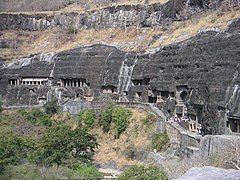









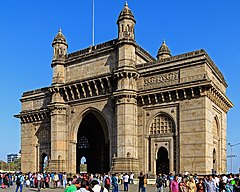



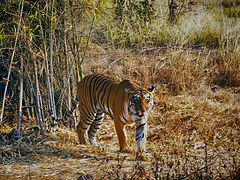
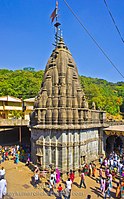
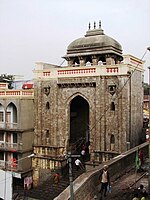



![The Haji Ali Mosque was built in 1431, when Mumbai was under Islamic rule.[20]](http://upload.wikimedia.org/wikipedia/commons/thumb/d/d4/Mumbai_03-2016_11_Haji_Ali_Dargah.jpg/240px-Mumbai_03-2016_11_Haji_Ali_Dargah.jpg)

